
- 182 pages
- English
- ePUB (mobile friendly)
- Available on iOS & Android
Sustainability Performance and Reporting
About this book
This book provides a step-by-step approach for organizations to reap benefits from a more sustainable approach. As organizations tackle global challenges, the faces of our businesses and our economic system are changing to consider the interests of all stakeholders rather than just shareholders. This book provides a step-by-step approach for organizations to reap benefits from a more sustainable approach. It begins with a brief history of the concept of sustainability as it applies to both performance and reporting. Implementing sustainability in an organization begins with the development of policies which are consistent with the expectations of its stakeholders. An organization's active participation in multi-stakeholder initiatives helps to align the policies with societal trends. Once the policies are developed, a management system is crucial to ensure congruence of policies with actual performance. Then, periodic reporting of performance based on well-recognized standards aids stakeholders in assessing an organization's performance–reporting also helps stakeholders to determine if performance aligns with their expectations. Both internal and external assurances build stakeholder trust in the organization's performance and reporting. Finally, the book concludes with a reflection on key messages and potential future actions for continuous improvement.
Frequently asked questions
- Essential is ideal for learners and professionals who enjoy exploring a wide range of subjects. Access the Essential Library with 800,000+ trusted titles and best-sellers across business, personal growth, and the humanities. Includes unlimited reading time and Standard Read Aloud voice.
- Complete: Perfect for advanced learners and researchers needing full, unrestricted access. Unlock 1.4M+ books across hundreds of subjects, including academic and specialized titles. The Complete Plan also includes advanced features like Premium Read Aloud and Research Assistant.
Please note we cannot support devices running on iOS 13 and Android 7 or earlier. Learn more about using the app.
Information
- • Recognize that companies are rethinking capitalism to be inclusive of the concepts of sustainability and stakeholders.
- • Clarify the dimensions of sustainability and the role of stakeholders.
- • Identify events that helped to shape the concept of sustainability over the years.
- • Compare and interpret various models used to represent sustainability.
- • Private ownership of most resources through shareholder ownership;
- • Competitive markets providing high-quality goods and services based on supply and demand;
- • Low amount of government interference and regulation;
- • Individuals working to create wealth in their own self-interest; and
- • Growth and expansion through reinvestment of profits.
- • economic (products and services are provided profitably);
- • social (all members of society share the wealth and enjoy a high quality of life);
- • environment (economic and social activities should leave the planet with diverse, plentiful resources for the use by, and enjoyment of, current and future generations).

Table of contents
- Cover
- Halftitle
- Title
- Copyright
- Dedication
- Abstract
- Contents
- Introduction
- Chapter 1
- Chapter 2
- Chapter 3
- Chapter 4
- Chapter 5
- Chapter 6
- Chapter 7
- Chapter 8
- Glossary
- Referenxe
- About the Author
- Index
- Backcover